
Established in 1996 and incorporated in 2001, Baxco Pharmaceutical, Inc. produces over-the-counter nutraceuticals and vitamins, mostly soft gels, under its own brand name and as a contract packer. Its UBB Vitamins line has been one of the leading brands of multivitamins and supplements to Southeast Asia, particularly Vietnam, and the company has now begun marketing the products in the U.S. and Canada. The company started out purchasing the packaged products for resale, but last year, it installed a new packaging line to run its products. "We had some complaints in the past, and this lets us ensure top quality without relying on anyone else," says CEO Dennis Wong.
After talking to them at WestPack last year, Baxco chose a complete packaging line from CVC Technologies, Inc. (www.cvcusa.com). "We were very impressed with the quality and price of their machines, as well as their service," says Wong. "They visited our plant and presented several possible layouts, and we decided on a U-shaped line because it minimizes the number of workers required. One operator can monitor a number of machines. Another real advantage is that CVC is only an hour away from us. They installed the line at their plant, and it was easy for us to visit them and watch the line run our bottles. Then, they installed the line at our plant and trained our operators."

A dispenser cuts desiccant packets from a roll and inserts them into the bottles as they continuously pass beneath.
The line at Baxco incorporates mainly CVC machines, although it includes a desiccant inserter from Azco Corp. (www.azcocorp.com) and a tamper-evident neck bander and heat tunnel from Marburg Industries, Inc. (www.marburgind.com). "The desiccant inserter illustrates how well CVC treated us," says Wong. "I bought a different inserter, but this new machine came out, and they replaced the one I had bought at no cost."
The packaging line starts with a loading turntable onto which a worker manually places the bottles. They then travel to an Azco SP-4D SUR-PAK(TM) pouch dispenser, which cuts desiccant pouches from a roll and inserts them into the bottles as they pass continuously beneath the machine. The desiccant web is driven by a series of upper and lower belts creating a tractor feed through a dancer-style motorized unwind. The belts are turned by a direct-current brushless stepper motor that enables the speed to be adjusted to maintain consistent web tension.
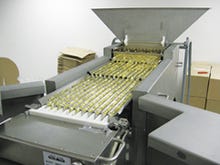
Capsules discharge from a hopper on the filler into 12 counting channels on three vibratory trays in a series. Each individual channel is equipped with eight product sensors to count each product in free-fall.
An optical sensor detects a window in the seal between the desiccants and signals the unit to cycle. Sensors shut down the unit if the desiccants are not entering the machine or if it is not being delivered to the bottle. State-of-the-art electronics accurately register cut position even with irregular pouch lengths, to ensure no miscuts and no stopping. Setup changes are made through a membrane keypad that accesses a microprocessor. An RS232 Windows-based interface option enables customers to download parameters directly from a PC to Azco's dispenser without operator intervention.
The bottles leaving the inserter travel to a CVC Model 1220 tablet/capsule counter and filler. The capsules discharge from a hopper on the machine into 12 counting channels on three vibratory trays in a series. Each individual channel is equipped with eight product sensors to count each product in free fall fashion, as well as a detecting system that automatically self-adjusts sensor sensitivity to offset the gradual accumulation of dust on the sensor window. The counter/filler, which can instantly recall data for setup accuracy and efficiency, has memory for up to 50 preprogrammed data settings, such as vibrating pulse, vibrating frequency, filling time, quantity per container and more.
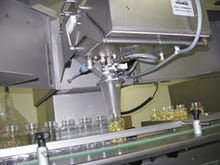
Capsules drop from the trays through a filling nozzle that dips to cover the neck of each advancing bottle, thus avoiding product spillage during the filling operation.
The unit accurately senses all shapes and sizes of products, including tablets, capsules, caplets, soft gels and transparent soft gels, and it can also detect half capsules. "We run a number of different size capsules, and we can set their sizes into the computer," says Wong. "The counter reads the size of the pills and rejects any that don't match. It will also detect capsules that are broken in half, which is really beneficial."

Caps are applied by an in-line capper.
Capsules next drop from the trays through a filling nozzle that dips to cover the neck of each advancing bottle, thus avoiding product spillage during the filling operation. An auto-rejection system removes incorrectly filled containers from the conveyor and resets the bottle count to display the correct number. The machine can also be programmed to stop immediately when a bottle is incorrectly filled. The unit can run up to 60 bottles/min, and count quantity can be set from one piece to 9,998 pieces/bottle. An additional counting unit can be added in the future to double the current line speed.
Next, the bottles are conveyed to a CVC 1205 in-line capper. Caps for the bottles are loaded into a floor hopper, and an elevator lifts them to the top of the machine where they enter the cap track. The caps must be presented to the cap hopper with the open side facing outward, so the slats on the elevator are designed so that caps that are lifted from the floor hopper with the top side facing inward will fall back into the hopper. Caps travel down the cap chute and are picked off of the feed lip by the bottles as they pass beneath. The cap chute is adjustable for different sizes of caps and has a sensor to detect the caps in the chute. The cap elevator will stop when the cap chute is full.
After the bottles pick the caps from the chute, they travel past four pairs of capping spindles that tighten the caps. The machine features CVC's unique capping torque setting mechanism in which the cap-tightening torque can be set to meet the different torque-level requirements of bottles for different applications. A calibrated dial on each pair of spindles enables the proper torque to be set for each bottle and enables the torque to be easily reset when changing from one bottle to another.
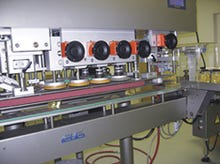
After the bottles pick the caps from a chute, they travel past four pairs of capping spindles that tighten the caps. Sensors at the outlet of the capper detect bottles with missing caps or insufficient torque and automatically reject the bottles.
Sensors at the outlet of the capper detect bottles with missing caps, missing foil liners or insufficient torque and automatically reject them. "We run a numbr of different bottles with different cap sizes, and the dials on the spindles make it very easy to set the proper torque required for each bottle," says Wong. "It's just another one of the ways that CVC made this line very operator-friendly."
Bottles leaving the capper are conveyed to a CVC 300CR-108 wraparound labeler. A wheel spaces each bottle as it enters the labeler, and the bottle then triggers the labeling head, which dispenses one label at a time. This places the leading edge of the label against the bottle, which then enters the wiping section, where a belt presses against the side of the bottle and rotates it so the label is wrapped completely onto the bottle. The labeler is equipped with a hot-stamp printer that prints a lot number and production and expiration dates onto the label before it is applied. A servo drive on the labeling head and encoders on the conveyor motors ensure precise placement of the label. As with the capper, gauges enable the operator to set the machine precisely for different bottles.
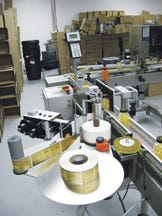
Labels are applied by a wraparound labeler that is equipped with a hot-stamp printer that prints a lot number and production and expiration dates onto the label before it is applied.
The labeler is equipped with CVC's SelfSet(TM) encoder system that ensures precise label placement by instant synchronization of all moving parts. The SelfSet system automatically calculates the optimum sensitivity and label placement without moving the label sensor. When the first product passes the product sensor, the SelfSet microprocessor scans and identifies the product length or diameter and the label length, and it then sets and synchronizes the labeling position, dispensing speed and label-protrusion position. It takes only one bottle and three seconds to complete the procedure. The system can save up to 50 jobs in memory and can recall them at the push of a button.
Next the bottles are conveyed to a model M500 continuous-motion Autocapsealer from Marburg Industries to apply tamper-evident bands over the tops of the bottles. A roll of tubular material is mounted on the back of the machine and is pulled down into the machine, where it passes over a mandrel to open it, after which the piece for the neckband is cut off the tube and pushed down over the bottle. An operator programs the length of the tamper-evident band desired, and this can be retained in memory on the control unit for the machine. Bottles leaving the bander enter a Marburg shrink tunnel that uses radiant tubular heaters. The finished bottles are conveyed to a collection turntable from which workers manually pack them into cases.
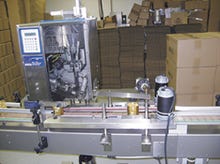
A continuous-motion neck bander, above, cuts tamper-evident bands from a tube of material and places them over the tops of the bottles.
"As part of the line, CVC installed sensors at strategic points to shut down machines if bottles back up and then restart the machines automatically when the bottles start moving," says Wong. "They also installed large, red emergency-stop buttons that an operator can hit if there is a problem. All-in-all, CVC thought of everything we might need. They did an excellent job for us at the beginning of the project, and they have continued to give us excellent service. The line has run very well, and if I have any kind of a problem, they're here immediately."
More information is available:
CVC Technologies, Inc., 909/466-8324. www.cvcusa.com.
Azco Corp., 973/439-1428. www.azcocorp.com.
Marburg Industries, Inc., 760/727-3762. www.marburgind.com.
About the Author(s)
You May Also Like


